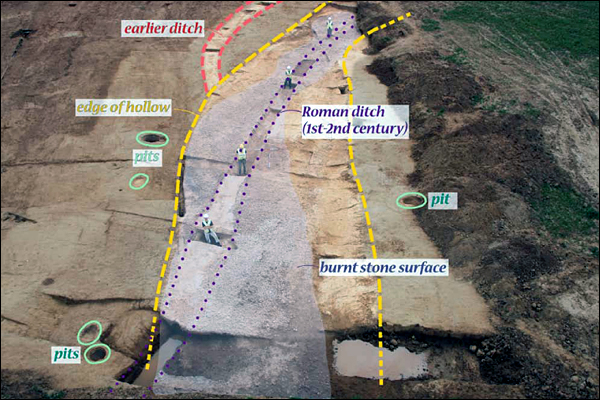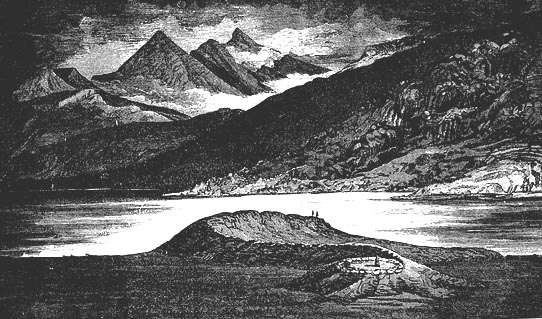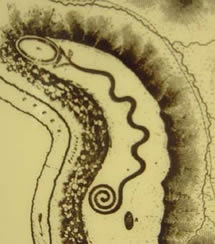|
|
![]()
Britain's first prehistoric serpent mound to be buried beneath bypass

Hereford Council officially released overhead of the Rotherwas Serpent Mound (Pic Credit: AP/Hereford Council)
A Report by Andrew Collins Published: July 7, 2007
LONDON: A Bronze Age
Serpent mound - seen as unique to Europe - has been uncovered by archaeologists
at the site of a new highway.
Excavations at Rotherwas in Herefordshire have revealed a 60-meter (65-yard),
three-dimensional serpentine mound made from piles of fire-cracked stones.
These form a series of linked opposing curves, creating a zigzagging
mosaic pathway that bears striking similarities to a similar mound structure
in Ohio, USA.
The 'Rotherwas Ribbon',
as archaeologists have damply christened it - is orientated roughly
north-south, at right angles to the new road, and has a 'tail-like feature'
at one end.
Herefordshire County
archaeologist Keith Ray, who is leading the excavations, proposes that
the serpentine structure was a ritual centre for the Bronze Age peoples
who inhabited the area some 4,000 years ago.
'It's the only structure
we have from prehistory from Britain or in Europe, as far as we can
tell, that is actually a deliberate construction that uses burnt stones,'
Ray said. 'This is ... going to make us rethink whole chunks of what
we thought we understood about the period.'
Archaeologists believe
that the fire-cracked stones used in the construction of the mound were
created when rocks from a ridge half a mile away were heated in a hearth
and then dropped in water to heat it up.
The use of fire-cracked
stones at Rotherwas is thought to be deliberate, and thus may have ritual
significance.
This is backed up
by the discovery close by of cremated human remains and burnt timbers,
a clear indication of the monument's powerful presence in the landscape.
Henry Chapman of the University of Birmingham, who is working with Dr
Ray in trying to understand the purpose of the serpent mound, adds that
the use of fire-cracked stones could easily have resulted from the desire
to connect aspects of everyday life with ritualistic practices.
'Using domestic waste
in funeral material is very significant in terms of linking life and
death,' Chapman said. 'It's a really neat expression of the psychology
of the period.'
The Rotherwas Serpent Mound is one of the most important discoveries in British archaeology for a very long time. In order to preserve it for future generations detailed plans are being drawn up to encase the site in a protective structure beneath the new road.
THE ROTHERWAS SERPENT MOUND - ITS GREATER IMPLICATIONS
On reading this story,
released by Herefordshire Council with pictures on 4th July 2007, I
was struck by how calm the reports seem to be dealing with the fact
that one of the most unique prehistoric monuments ever found in Britain
is being condemned without mercy to a concrete existence beneath a new
access road.
The term 'preserve it for future generations' is exactly what English
Heritage and the National Trust say about the many megaliths known to
be buried beneath the Avebury henge monument. What this in fact means
is that no one can ever touch them, not now or in the future.
So to put the term
'preserve it for future generations' in plainer terms, it means that
the Rotherwas Serpent Mound will be encased in concrete and tarmac and
quietly forgotten about by all but the most dedicated earth mysteries
enthusiasts. This is a terrible shame, for its existence, not to mention
the site it occupies, offers a unique opportunity to study the religious
beliefs and practices of the Bronze Age mindset some 4,000 years ago.
Remember, Rotherwas is just 85 miles (136 kms) from Avebury, where in
2000 BC serpentine avenues of standing stones were still under construction.
The fact that the
public were not made aware of the discovery of the Rotherwas Serpent
Mound until now, also smacks of the site being kept under raps for fear
of road protesters and eco-warriors occupying the site, and, in the
resulting publicity, forcing a public debate on whether or not the Rotherwas
access road was valid or not. This is a terrible shame, and if at this
advanced stage there is anything anyone can do to save the Rotherwas
Serpent Mound, then please do it.
We shall report again on this matter in due course.
BRITAIN'S OTHER SERPENT MOUND
The Rotherwas Serpent
Mound is being hailed as unique to Europe. However, this might not be
the case, for a serpent mound of very similar age and appearance once
existed close to the banks of Loch Nell (or Loch-a-Neala, meaning 'Lake
of the Swans'), some 3 miles (4 kms) south of Oban on Scotland's west
coast. It was explored in 1871 by Mr JS Phene, FSA, who determined through
excavation that at its western extremity, identified as the serpent's
'head', was a cairn of stones beneath which were 'three large stones
forming a megalithic chamber, which contained burnt bones, charcoal,
and burnt hazel-nuts,' as well as a flint implement.
Just one year later the structure was visited by travel writer and painter Constance Gordon Cumming, who gave an account of it in a work entitled Good Words, published in 1872, and again in her book In the Hebrides, published in 1883. In here she describes the monument as 'a huge serpent-shaped mound', as well as 'a very remarkable object, and one, moreover, which rises conspicuously from the flat grassy plain, that stretches for some distance on either side, with scarcely an undulation, save two artificial circular mounds, in one of which lie several large stones, forming a cromlech. These circles are situated a short distance to the south, to the right of the Reptile.'

The Loch Nell Serpent Mound taken from Constance Cumming's In the Hebrides (1883)
Cumming said the structure
was totally artificial, and estimated its size to be around 17 to 20
feet in height and some 300 feet in length. According to her it was
'perfect in anatomical outline', while on its head was a 'circle of
stones, supposed to be emblematic of the solar disc'.
Prior to Mr Phene's
visit in 1871, Cumming recorded that at the centre of the stone circle
were 'some traces of an altar', although this had now disappeared due
to the presence of cattle and herd boys.
Phene, as quoted in Cumming, provided the following account of the serpent's spine:-
On removing the peatmoss and heather from the ridge of the serpent's back, it was found that the whole length of the spine was carefully constructed, with regularly and symmetrically placed stones, at such an angle as to throw off the rain.
Cumming herself described
the spine as 'a long narrow causeway, made of large stones, set like
the vertebrae of some huge animal.' which surely bears some resemblance
to the Rotherwas Serpent Mound, with its own mosaic-like pathway.
She goes on: 'They [the vertebrae] form a ridge, sloping off at each
side, which is continued downward with an arrangement of smaller stones
suggestive of ribs.'
The mound was built
in such a manner that the worshipper standing at the altar 'would naturally
look eastward, directly along the whole length of the Great Reptile,
and across the dark lake, to the triple peaks of Ben Cruachan. This
position must have been carefully selected, as from no other point are
the three peaks visible.'
The Ben Cruachan are
sacred mountains associated in legend with the Cailleach Bheur, the
old hag of the mountains, while the serpent mound itself was once said
to be the burial place of the Scottish folk-hero Ossian, son of Fingal.
The Cailleach Bheur
is considered the dark half of the Irish and British goddess Brigid,
who principal zoomorphic symbols are the serpent and swan, reflecting
he root of loch Nell's name and the presence on its shores of the serpent
mound.
The Loch Nell Serpent
Mound, with its cairn, stone-lined cist and cremated remains, appears
to date back to a similar age as the Rotherwas Serpent Mound, ie. to
the Early Bronze Age, c. 2000 BC. Thus a relationship might exist between
the two cultures responsible for these prehistoric monuments hundreds
of miles apart.
It might pay the archaeologists
working currently at Rotherwas to visit Loch Nell to study the environment
and topography behind the siting of such monuments.
Today the Loch Nell serpent mound is in a ruinous condition, although the cairn at its head, as well as the undulating ribbing of piled stones, are still partially visible.
COMPARISONS WITH OHIO'S
SERPENT MOUND
Regarding the comparisons
with Ohio's own Serpent Mound, located in Serpent Mound Park, Adams
County, the matter becomes that much more tricky, even though the similarities
between the two are striking to say the least.
They include the fact that an oval shaped mound held in the jaws of
the serpent's head once possessed a mound of stones, according to the
ethnologist Frederic Ward Putnam, who investigated the site back in
1890. According to him:
|
Ohio Serpent Mound from above. |
Many of the stones show signs of fire, and under the cliff are similar burnt stones which were probably taken from the mound years ago; for I have been informed by an old gentleman, who remembered the stone mound as it was in his boyhood, that many stones taken from the mound were thrown over the cliff (Putnam, The Serpent Mound of Ohio, 1890. |
Dr Keith Ray, the
Herefordshire Council archaeologist in charge of the excavations at
Rotherwas, has made it clear that he does not believe there is any historical
or cultural link between the two serpent mounds, which were built over
3000 years apart. Despite this the similaries cannot be overlooked,
and should be examined without prejudice.
![]()
|
|
